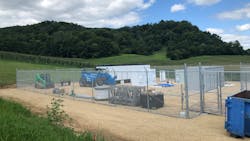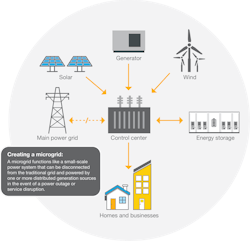Community Microgrid a First for Wisconsin
The Alliant Energy project, which leverages emerging technologies to solve unique reliability issues, is expected to provide new insights and opportunities to improve customer service. One driving force behind the utility’s desire to pursue the development of microgrid technology is the potential integration with new clean energy resources.
Clean Energy Blueprint
Alliant Energy’s clean energy blueprint outlines its plans to accelerate the transition to renewable energy in both Iowa and Wisconsin. As part of its transition, the utility plans to retire all coal from its generation fleet by 2040. The utility also aspires to achieve net-zero carbon dioxide emissions from the electricity it generates by 2050.
“Our plan enhances the economic and environmental health of communities,” said Ben Lipari, assistant vice president of resource development at Alliant Energy. “Along with contributing to a healthy environment, adding renewables creates jobs, provides lease payments to landowners and attracts new businesses to communities. And from a financial standpoint, it’s a smart investment in the communities we proudly serve.”
With the rapid development of intermittent and more distributed renewable energy sources, the utility also is looking at new opportunities for energy storage solutions to deliver increased value to customers and communities.
Enter The Microgrid
A microgrid is a small-scale utility grid with islanding capabilities, meaning it can be disconnected from the traditional grid and operate independently in the event of a power outage or service disruption. When disconnected from the central grid, microgrids serve customers in a defined area with power from one or more distributed generation sources, such as battery, wind, solar or a combination of these, to improve reliability.
Microgrids come in all shapes and sizes. Just as many critical infrastructure facilities rely on a backup generator during a power outage, microgrids can be designed to serve customers across small and large areas with a variety of generation sources. They primarily are designed to improve reliability and resiliency and can be tailored to address the unique requirements of the customers they serve.
The Perfect Place
To gain real-world experience operating and maintaining a microgrid, Alliant Energy sought to develop a community-wide pilot project.
“Our goal from the outset was to see how we could deploy innovative, cutting-edge technical solutions to improve reliability, advance research opportunities and accelerate the transition to cleaner, renewable energy,” said Mike Bremel, director of engineering and customer solutions at Alliant Energy. “Boaz’s uniqueness provided us a perfect opportunity to build upon our research efforts, to pilot and possibly expand the scope of this type of microgrid project to maximize the benefit to the distribution system and customers.”
Alliant Energy evaluated several communities as potential microgrid host site candidates, including Boaz. Located roughly 75 miles (120 km) west of Alliant Energy’s headquarters in Madison, Wisconsin, the small, rural community is home to more than 100 mostly residential and small-business customers.
Over a three-year period, the project team considered total load, the number of outages, average length of outages and existing transmission infrastructure. Ultimately, Boaz was chosen as the location for this project after considering various criteria and site factors. In fact, during the evaluation period, the Boaz community experienced 10 outages of five minutes or longer, with the longest outage being approximately seven hours. One reason for the high frequency of outages and disruptions: The community is served by a single 15-mile (24-km) long overhead line.
Undergrounding the line was one potential alternative the utility considered to address reliability concerns; however, the line itself is fully operable and relatively new. Therefore, Alliant Energy could not justify such a costly and extensive rebuild project. Instead, the utility concluded that developing a microgrid project would deliver the identified reliability benefits to Boaz, while providing additional value and learning opportunities to its team members. Plus, it could be built in a cost-effective manner.
Siting and Design
Planning and developing the first community microgrid in Wisconsin was no small undertaking. Finding land to site the project was the first challenge because of floodplain zoning. The Driftless Region in southwest Wisconsin has experienced several significant flooding events in recent years, but the project team was able to locate and secure a suitable 2-acre (0.8-hectare) parcel for the project along the distribution line just south of the village.
From the start, Alliant Energy enlisted the services of Fractal Energy Storage Consultants, a specialized engineering firm the utility previously had partnered with on battery storage installations. With a wealth of analytic and advising experience, Fractal Energy Storage Consultants assisted with system planning and development. WEG was selected as the engineering, procurement and construction partner responsible for aligning project design details, construction and commissioning.
At its core, Alliant Energy required a 400-kW, 3200-kWh capacity energy storage system that could maintain a system protection scheme even when islanded. To meet local needs during a potentially extended outage, the microgrid relies on two 1.6-MWh lithium-iron-phosphate battery (LFP) modules, for a combined 3.2 MWh of energy storage capacity. The system is designed to provide more than eight hours of backup power to the community at peak load in the event of an outage. A series of breakers, Schweitzer Engineering Laboratories (SEL) relays and three 1.2-MVA inverters, one of which that operates in island mode only, also are integrated into the project.
Special Challenges
The unique specifications of this microgrid system required Alliant Energy and its engineering partners to explore equally unique solutions to challenges related to this project.
Normal system protection on Alliant Energy’s distribution system requires fuses to be coordinated, so if a fault current occurs, the smallest number of customers are impacted — whether the affected fuse is on the service transformer or single-phase tap.
Faults on the system cause more current to flow than the loads on the system. Fuses are sized to carry more current than the loads require, but they will blow with the higher currents caused by fault conditions. The greater the difference between load and fault currents, the easier it is to size the fuse to operate reliably.
This presents a challenge for microgrids, because inverters are normally sized to the load and cannot supply much additional current. If a fault occurs in a microgrid that is islanded or not connected to the grid, the inverters do not supply enough current to blow the grid-sized fuses.
While most microgrids use specialized equipment to protect the system when lower current is available in island mode, the Boaz microgrid is designed to supply enough current to operate the fuses within the microgrid even when islanded. Much larger inverters than needed for the load are used to supply enough current to operate the system protection fuses if a fault occurs in the islanded microgrid. This is a unique feature that sets the Boaz microgrid apart from most others.
Another benefit of the new system’s fast, seamless transitions is the ability to collect additional information on the number of blinks, or small service disruptions, Boaz experiences. Any outages over a few cycles will trigger the system’s islanding capability, so the engineering team receives more accurate data on service reliability.
Planned communication upgrades eventually will enable the project team to consider integrating additional generation resources, explore additional use cases and expand potential testing opportunities.
Piecing it all Together
Construction at the 2-acre project site began in the spring of 2022. Despite the potential for supply chain disruptions and delays that have plagued other industry projects, the Boaz microgrid project team has been able to avoid major issues with equipment procurement and delivery constraints. Project construction and commissioning remains on track. At this time, the Boaz microgrid project team expects the system to be placed into service by the end of 2022.
“At Alliant Energy, we’re constantly looking for ways to deliver on our purpose-driven strategy to serve customers and build stronger communities,” Bremel said. “From an engineering standpoint, this infrastructure upgrade ensures the Boaz community — residents and businesses alike — will have access to safe and reliable power, while providing Alliant Energy operational experience and knowledge that may be applied to future development and research.”
This project is one of several advanced research pilot projects Alliant Energy is implementing across its service footprint as it continues to diversify its renewable energy portfolio and expand access to energy storage solutions. The utility already has placed several battery energy storage systems into service throughout Iowa and Wisconsin. Like the Boaz microgrid, these battery systems have delivered unique solutions to better serve Alliant Energy’s customers and build stronger communities.
“Investments in new energy solutions are shaping the transition to more local, resilient and reliable renewable power production for generations to come,” said Lipari. “At the end of the day, a smarter energy grid means customers get more control, greater flexibility and increased number of choices.”
Identifying challenges, exploring solutions and producing results is what drives Alliant Energy to power beyond. As the electric grid continues to evolve, projects like the Boaz microgrid are delivering new and innovative solutions — all while reducing reliance on fossil fuels and avoiding costly infrastructure upgrades. By leveraging the expertise and creativity of its teams and project partners, Alliant Energy is proving once again that big things can happen in small towns.
J.P. Brummond is vice president of customer and community engagement at Alliant Energy, a public utility holding company headquartered in Madison, Wisconsin. Brummond oversees economic development and customer support services as well as two generating stations in Wisconsin. In addition to being a member of the University of Wisconsin–Madison Erdman Center for Operations and Technology Management’s Advisory Board, Brummond serves on the Board of Directors for the Midwest Reliability Organization and Wisconsin Manufacturers and Commerce Foundation Board.
Company Listings
Fractal Energy Storage Consultants | www.energystorageconsultants.com
WEG | www.weg.net
About the Author
J.P. Brummond
J.P. Brummond is vice president of customer and community engagement at Alliant Energy, a public utility holding company headquartered in Madison, Wisconsin. Brummond oversees economic development and customer support services as well as two generating stations in WPL. In addition to being a member of the University of Wisconsin–Madison Erdman Center for Operations and Technology Management’s Advisory Board, Brummond serves on the Board of Directors for the Midwest Reliability Organization and Wisconsin Manufacturers and Commerce Foundation Board.




